


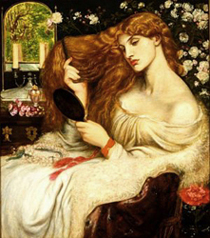

Art in Willa Cather's Fiction
Song of the Lark (1915)

The extent to which Willa Cather was interested in and influenced by art has been carefully documented by Polly P. Duryea in her 1993 dissertation Paintings and Drawings in Willa Cather's Prose: A Catalogue Raisonne. To facilitate appreciation of Cather's art allusions, I have gathered together here images of the art identified by Duryea and selected quotations and commentary from her dissertation.
Cather's Song of the Lark is a novel about the artistic development of Thea Kronberg as she moves from her rural beginnings in Colorado to Chicago and the Southwest on her way to becoming a famous opera singer.


Jules Bréton, The Song of the Lark, 1884.
- Thea at the Chicago Institute of Art:
- "But in that same room there was a picture--oh, that was the thing she ran upstairs so fast to see! That was her picture. She imagined that nobody cared for it but herself, and that it waited for her. That was a picture indeed. She liked even the name of it, 'The Song of the Lark.' The flat country, the early morning light, the wet fields, the look in the girl's heavy face--well, they were all hers, anyhow, whatever was there. She told herself that that picture was 'right.' Just what she meant by this, it would take a clever person to explain. But to her the word covered the almost boundless satisfaction she felt when she looked at the picture" (SOL 179).
- Cather art review:
- "You will find hundreds of merchants and farmer boys all over Nebraska and Kansas and Iowa who remember Jules Bréton's beautiful 'Song of the Lark,' and perhaps the ugly little peasant girl standing barefooted among the wheat fields in the early morning have taught some of these people to hear the lark sing for themselves" ("Chicago Art Institute." Courier 10 Aug. 1901: 1-3; W & P 842-46).
- Jim Burden's image of Lena based on Breton's painting [My Antonia]:
- "One dream I dreamed a great many times, and it was always the same. I was in a harvest-field full of shocks, and I was lying against one of them. Lena Lingard came across the stubble barefoot, in a short skirt, with a curved reaping-hook in her hand, and she was flushed like the dawn, with a kind of luminous rosiness all about her. She sat down beside me, turned to me with a soft sigh and said, 'Now they are all gone, and I can kiss you as much as I like'" (MA 125).

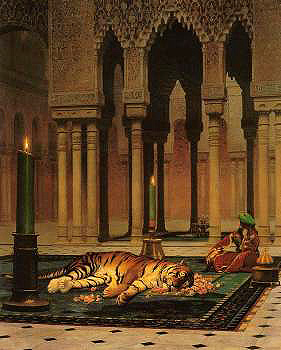
Léon Gérôme, The Grief of the Pasha, 1896
- Cather:
- "It was with a lightening of the heart, a feeling of throwing off the old miseries and old sorrows of the world, that she [Thea] ran up the wide staircase to the pictures. There she liked best the ones that told stories. There was a painting by Gérôme called 'The Pasha's Grief' which always made her wish for [her younger brothers] Gunner and Axel. The Pasha was seated on a rug, beside a green candle almost as big as a telegraph pole, and before him was stretched his dead tiger, a splendid beast, and there were pink roses scattered about him" (SOL 179).
- "Cather may also have read Victor Hugo's poem about the Pasha's grief for his pet tiger to her younger brothers," according to Duryea.


Jean-François Millet, Bringing Home the Newborn Calf, 1864.
- Cather:
- "She [Thea] loved, too, a picture of some boys bringing in a newborn calf on a litter, the cow walking beside it and licking it. The Corot which hung next to this painting she did not like or dislike; she never saw it" (SOL 179).
- Cather:
- "Do we not all admit that the man who can make these homely subjects into art is the greatest of all artists, and that the peasant folk of Millet are worthier a man of genius than the ballet dancers of Degas" (1901, "The Chicago Art Institute" W & P 846).
- "Returning Home . . . was shown as a loan from Samuel Untermeyer in the 1902 Carnegie Catalogue along with three other Millet paintings. Cather's character, Mr. Nathanmeyer in The Song of the Lark, was probably modeled after several famous collectors, such as Samuel Untermeyer, a lender to Carnegie exhibits, and H. O. Havemeyer, whose bequests are now in the Metropolitan Museum of Art, New York," according to Duryea.

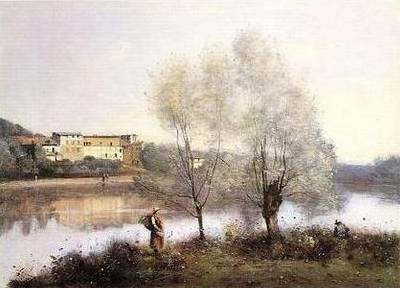
Jean-Baptiste Corot, Ville d'Avray, ca. 1860.
No specific Corot is named in the text, but Corot did a number of
Ville d'Avray
paintings which were widely known. Cather particularly
admired Corot's misty
morning landscapes, and Cather
lived for a time in Ville d'Avray, west of Paris.

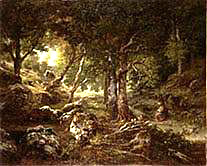
(Left) Jean-Baptiste Corot, Souvenir de Mortefontaine, 1864 and
(right) Pierre-Ettienne Theodore Rousseau, Forest of Fontainebleau, c. 1860
Examples of the Corot and Rousseau that Thea did not notice.
Both painters were associated with the "plein-air" painting of
the Barbizon school and the nearby Fontainebleau Forest.
- Cather:
- "'And Corots,' breathed Mrs. Anderson, tilting her head feelingly. 'Such examples of the Barbizon school!'" "This was meaningless to Thea, who did not read the art columns of the Sunday Inter-Ocean as Mrs. Anderson did. . . . The Corot which hung next to this painting she [Thea] did not like or dislike; she never saw it" (SOL 178-79).
- Cather:
- "Fred whispered that they were Rousseaus and Corots, very fine ones which the banker [Mr. Nathanmeyer] had bought long ago for next to nothing" (SOL 248).

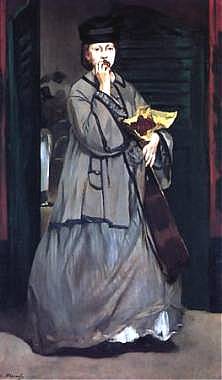
Edouard Manet, The Street Singer, 1862.
The singer's frank, unladylike enjoyment of grapes directly from a
brown bag and carelessly revealed petticoat are probably meant to
suggest her attitude towards her love affairs. The impressionist
Manet was Cather's favorite painter.
- Cather:
- "Mr. and Mrs. Nathanmeyer were alone in their great library. . . . One could merely see that there were pictures there. Fred whispered that they were Rousseaus and Corots, very fine ones which the old banker had bought long ago for next to nothing. In the hall Ottenburg had stopped Thea [Kronberg] before a painting of a woman eating grapes out of a paper bag, and had told her gravely that there was the most beautiful Manet in the world" (SOL 248).


Anders Zorn, Sommar, 1894
Cather does not specify a particular Zorn etching, but
this painting is typical of Zorn's bathing nudes.
- Fred's comment on Mr. Nathanmeyer's interest in nude etchings and Thea's fine figure:
- "Old Nathanmeyer," he {Fred] mused, "would like a peep at her now. Knowing old fellow. Always buying those Zorn etchings of peasant girls bathing. No sag in them either. Must be the cold climate" (SOL 287).


William Holman Hunt, The Awakening Conscience,1851-3.
Well-known painting about the epiphany/moral conversion of a "'kept
woman' surrounded by the material advantages provided by her lover."
- Cather:
- "It was in his [Ray Kennedy's] sentimental conception of women that they should be deeply religious, though men were at liberty to doubt and finally deny. A picture called 'The Soul Awakened,' popular in Moonstone parlours, pretty well interpreted Ray's idea of woman's spiritual nature" (SOL 125).

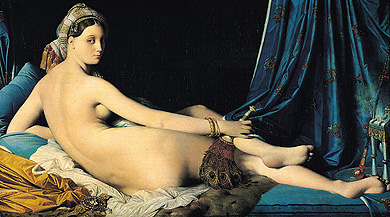
Jean-Auguste Ingres, Grand Odalisque, 1814.
Erotic odalisque paintings were fairly common, but Cather does not
specifiy
which one she has in mind. Ingres' odalisque was one of
the most well-known.
(Odalisque--inhabitant of a Turkish harem.)
- Cather:
- "[Ray Kennedy] even removed Giddy's particular pet, a naked girl lying on a couch with her knee carelessly poised in the air. Underneath the picture was printed the title, 'The Odalisque'" (SOL 100-01).

Related Resources:
Death Comes for the Archbishop
Comments/Suggestions: knichols11@cox.net
Updated: 12-14-12

